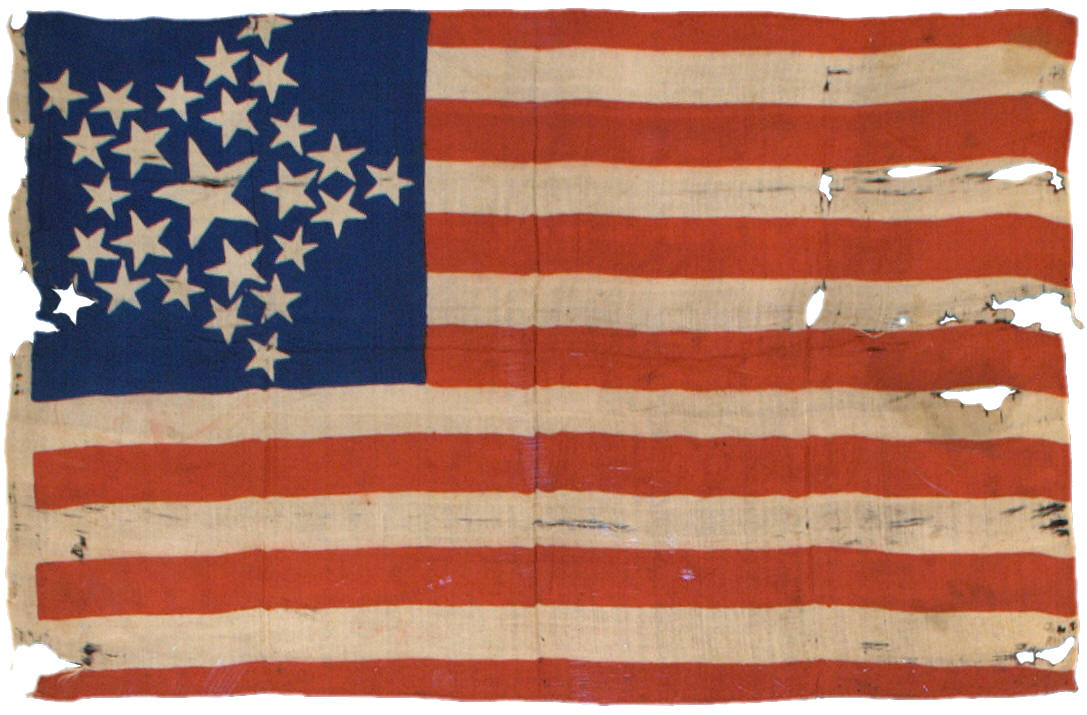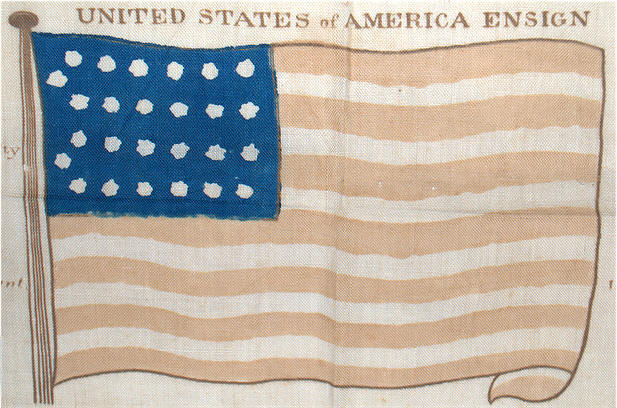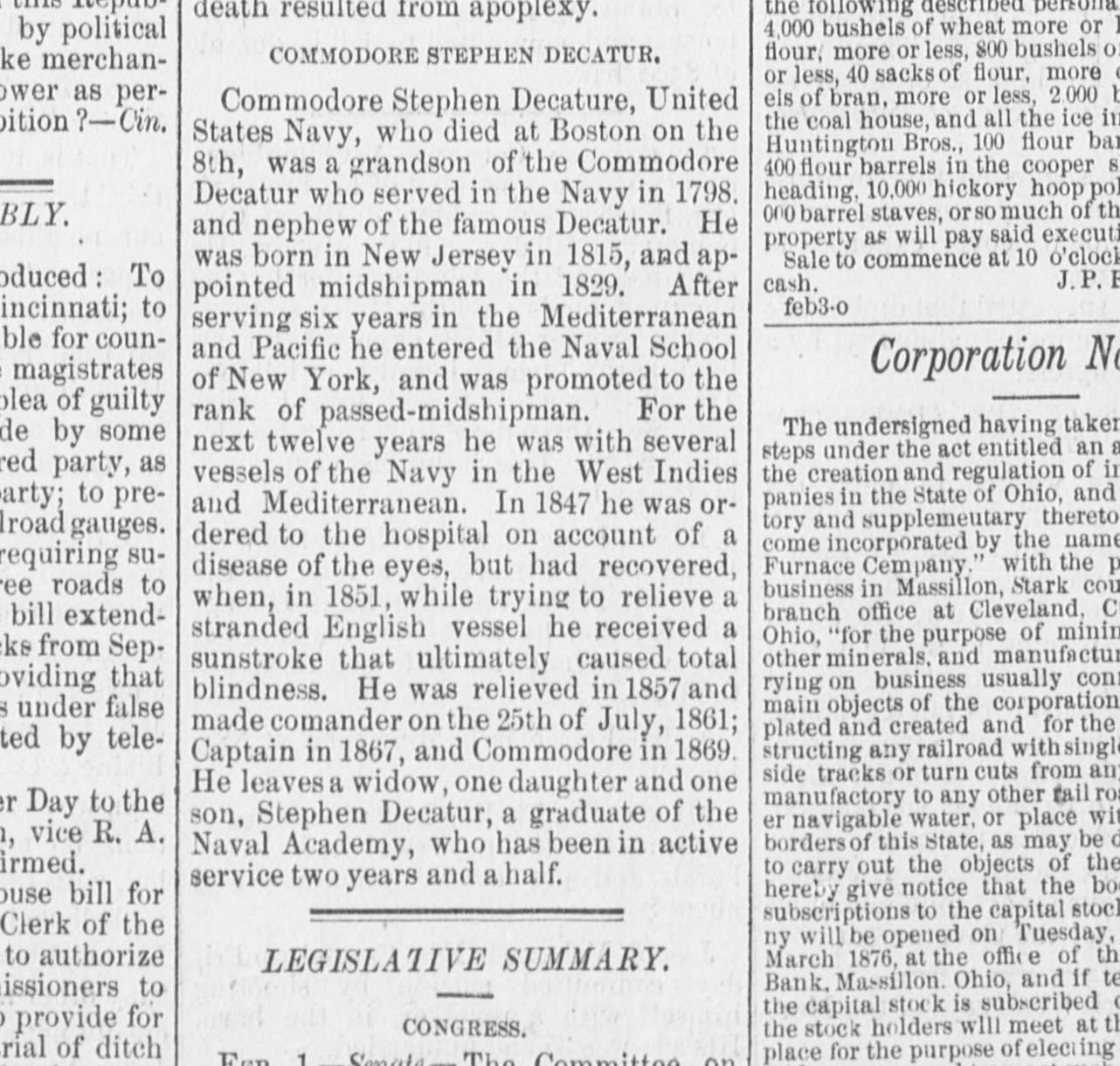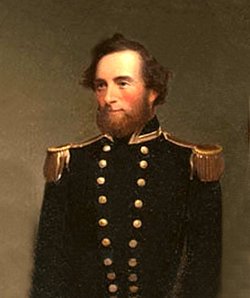|
 This
flag is special and extraordinary not only as one of the
earliest examples of the beloved "Great Star" pattern of
American Flags, but also as one of the earliest printed
flags known, and furthermore, a flag with specific
provenance to the Decatur family, one of America's
earliest and most renowned naval families. Captain
Samuel Reid, an American naval hero of the War of 1812,
designed the Great Star pattern in 1818, as a novel way
of incorporating the growing number of stars into the
canton. Reid's experience as a mariner, having to
determine the nationality of a ship at long distances
from its flag, most likely informed his decision to
propose such a bold, beautiful and easily recognizable
design. In the second quarter of the 19th century,
the Great Star pattern emerged as one of the predominant
forms of American flags, and remains today as one of the
most beautiful expressions of the American Union. This
flag is special and extraordinary not only as one of the
earliest examples of the beloved "Great Star" pattern of
American Flags, but also as one of the earliest printed
flags known, and furthermore, a flag with specific
provenance to the Decatur family, one of America's
earliest and most renowned naval families. Captain
Samuel Reid, an American naval hero of the War of 1812,
designed the Great Star pattern in 1818, as a novel way
of incorporating the growing number of stars into the
canton. Reid's experience as a mariner, having to
determine the nationality of a ship at long distances
from its flag, most likely informed his decision to
propose such a bold, beautiful and easily recognizable
design. In the second quarter of the 19th century,
the Great Star pattern emerged as one of the predominant
forms of American flags, and remains today as one of the
most beautiful expressions of the American Union.
|
The earliest known printed flags consist of
those with 26 stars, dating to the period
Michigan's statehood from 1837 to 1845.
Surviving examples from this period are
extremely rare, and are typically known in just
a handful of styles: an interesting row
configuration with two side outliers and four
even rows of six stars each, or two variants of
the great star pattern, of which this is one.
The colors of this flag are extremely vibrant
and beautiful, especially considering that
the flag was block-dyed over 170 years ago.
There are minor splits in the silk, but the
losses on the hoist, especially in the corners,
and the wear at the fly end, indicates that the
flag was most likely flown for some period of
time.
There are letters and notes from the Decatur
family indicating that this silk flag was owned
by Commodore Stephen Decatur (1779-1820) and
used by him in 1815 when he took command of the
squadron bound for the Mediterranean. Family
records also indicate that the flag along with
numerous other Decatur objects were leant to the
Naval Historical Foundation 1950 for a special
exhibit and also to be included in a book.
However, the 26 stars on the flag represents the
state of Michigan which came into the Union on
July 4, 1837. In addition, the lithography
process utilized in making flags did not begin
to be used until some time in the 1820s. The
likelihood is that this flag was used by
Commodore Stephen Decatur (1814-1876) son of
John Pine Decatur and namesake of his famous
uncle. Commodore Stephen Decatur was
appointed Lieutenant on March 2, 1841 and was
assigned to the Sloop Warren. It is believed
that he saw service in the Mexican war and the
dates of this flag would be appropriate for his
use and it may be this Commodore Stephen Decatur that
earlier family members meant to designate. It is
indeed a wonderful historical flag having
descended from one of this country’s most
illustrious nautical families. |
| |
 |
| This rare
printed kerchief of the Naval
Ensigns of the World, circa
1840, features a 26 Star
American Flag prominently in the
center. The flag demonstrates
other common star
|
 |
|
pattern of the
period--four rows of six stars
with two end outliers.
This kerchief was found in
London, where it was most likely
made for the American market.
Its purpose was for sailors to
use at sea to help identify
vessels. The kerchief is printed
on cotton, which would have been
more survivable at sea, whereas
paper would be more likely
deteriorate in the wet and salty
environment. It is
unusually large, at 24" x 32",
and, for a cotton item over 170
years old, survives in an
exceptional state of
preservation. |
|
|
 |

Commodore Stephen Decatur
(1814-1876) |
|

